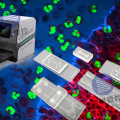Cell Capture Chip is an advanced microfluidic technology application widely used in biomedical research, medical diagnostics and life sciences.
This technology enables efficient capture, localization and analysis of cells through tiny fluidic channels and functional surface structures. In this paper, we will provide a detailed overview of the principles, application areas, advantages and future trends of cell capture microarrays.
Principles
The core principle of Cell Capture Chips is based on the combination of microfluidics and cell biology. Microfluidics enables highly precise manipulation of fluids through tiny channels and microstructures, while cell biology focuses on the structure, function and interrelationships of cells.
Cell capture chips typically feature tiny channels and surface microtextures through which cells can be captured, localized and immobilized under specific conditions. These chips can also selectively capture specific types of cells through different functionalized surfaces, enabling precise sorting of mixed cell populations.
Application Areas:
1 Biomedical Research
Microfluidic cell capture chip play a crucial role in biomedical research, allowing researchers to capture and analyze specific types of cells in an in vitro environment. This aids in gaining deeper insights into cellular physiology, metabolism, and signaling mechanisms. Additionally, cell capture chips are used in establishing disease models, opening new avenues for studying and treating diseases.
2 Medical Diagnostics
In medical diagnostics, microfluidic cell capture chips find extensive use in early cancer detection, circulating tumor cell analysis, and the diagnosis of various diseases. By capturing circulating cells from patient fluids, these chips provide more accurate and early diagnostic information, contributing to the development of personalized treatment plans.
3 Drug Screening and Development
Cell capture chips offer an efficient platform for drug screening and development. Researchers can capture target cells, assess the impact of drugs on cells, and optimize drug design. This enhances the efficiency of drug development and reduces the need for animal testing.
4 Organ-on-Chip Research
Cell capture chips are applied in organ-on-chip research by capturing and analyzing specific cell types to simulate the physiological and pathological states of organs. This is crucial for gaining a better understanding of organ function and the onset and progression of diseases.
Advantages
1 Precision in Cell Manipulation
Cell capture chips enable highly precise manipulation of cell capture, positioning, and analysis through small fluidic channels and surface microtextures, enhancing experimental accuracy and repeatability.
2 High Throughput Analysis
Compared to traditional methods, cell capture chips offer the advantage of high throughput. They can process a large number of cell samples simultaneously, accelerating the experimental process and improving data acquisition efficiency.
3 Selective Cell Capture
Due to functionalized surface designs, cell capture chips can selectively capture specific types of cells, achieving precise sorting of heterogeneous cell populations.
4.Sample and Reagent Savings
Cell capture chips typically require fewer samples and reagents, helping to save costs and reduce dependence on scarce samples.
Future Trends
As an emerging technology, microfluidic cell capture chips exhibit several trends in their future development
1 Multifunctional Integration
Future cell capture chips are expected to focus on multifunctional integration, not only capturing cells but also providing real-time monitoring, imaging, and analysis for more comprehensive cell information.
2.Application of Artificial Intelligence
The development of artificial intelligence (AI) technology is anticipated to further drive the application of cell capture chips. Applying AI algorithms to cell image analysis can enhance the accuracy and efficiency of cell recognition.
3 Three-Dimensional Cell Culturing
Future cell capture chips may emphasize simulating three-dimensional cell culture environments to better reflect the in vivo growth conditions, improving the biological similarity and reliability of experiments.
4.Biomarker Discovery
With technological advancements, cell capture chips will play a greater role in biomarker discovery. Analyzing captured cells can identify and validate new biomarkers, providing more possibilities for early disease diagnosis and treatment.
5.Personalized Medicine Applications
Microfluidic cell capture chips are poised to become a key tool in personalized medicine. By capturing and analyzing a patient's cells, personalized treatment plans can be devised for each individual, enhancing treatment specificity and effectiveness.
6.Industrialized Production
As the technology matures, the industrialized production of cell capture chips is expected to become more widespread. This will reduce the cost of chips, making them more accessible across various fields and promoting their widespread application in medicine, biology, and other domains.
Conclusion
Cell capture chips, as an application of microfluidic technology, hold tremendous potential and broad application prospects. Their high precision, throughput, and selective capture capabilities have garnered significant attention in biomedical research, medical diagnostics, and drug development. As technology continues to advance, cell capture chips are poised to play a crucial role in personalized medicine, biomarker discovery, and other key areas, providing robust support for scientific research and medical applications.
Dxfluidics Products

| Product Code | Outline (mm) | Height (um) | Small channel width (um) | Thickness (mm) | Chip material | Price (CNY) |
| H0001 | 40*15 | 25 | 20&10 | 4+1 | PDMS+Glass | 500 |
| H0002 | 36*17 | 25 | 130&30 | 4+1 | PDMS+Glass | 500 |
| H0003 | 27*15 | 300 | 270&10 | 4+1 | PDMS+Glass | 500 |
| H0004 | 27*15 | 300 | 270&40 | 4+1 | PDMS+Glass | 500 |
| H0005 | 46*27 | 20 | 20&10 | 4+1 | PDMS+Glass | 500 |
| H0006 | 25*15 | 25 | 30&10 | 4+1 | PDMS+Glass | 500 |
Ordering Methods



© 2025. All Rights Reserved. 苏ICP备2022036544号-1















